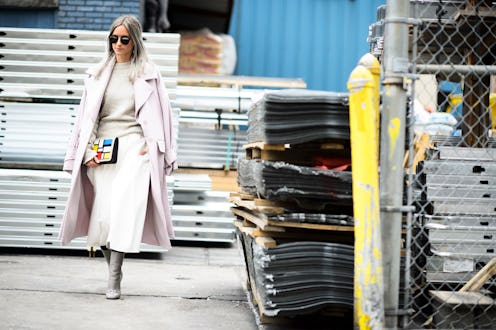No longer reserved for the—ahem—mature set, going gray has become a hair trend spotted on fashion insiders and editors alike. We love the idea of embracing the full color spectrum (pastel and neon, eat your heart out) as legitimate options for your mane’s new hue, but understand that adopting the look takes a bit of gusto. We tapped color expert Aura Friedman of Sally Hershberger Downtown Salon for advice on what to consider before embracing your outer silver fox.
Hello, Silver Fox
#1 Thing To Consider Before Going Gray
Newly gray blogger Charlotte Groeneveld with Aura Friedman. Photo: @auracolorist
"The most important thing to evaluate is if your hair can take the bleaching process, however you decide to do it. Whether it's highlights or a double process, you need it to first be a pale yellow in order to neutralize and tone it gray."
Why Gray Is Becoming The New "It" Color
Sarah Harris, Fashion Features Director of British Vogue, takes to the streets with her signature gray mane. Photo: Adam Katz Sinding
"It's cool and works well on both fair and olive skin tones. It looks amazing with blue, green or gray eyes."
"The basic process of going gray involves two key steps: bleaching and toning."
Consider Your Hair's Current Health
Aura added dark gray stripes to her client Samantha's already-icy mane. Photo: @auracolorist
"Not all hair types can go gray. Hair needs to be able to look good and withstand the bleaching process so it highly depends on density, texture, existing color and pre-existing color."
How To Maintain The Color
Multidimensional gray hair keeps the look from appearing dull. Photo: Adam Katz Sinding
"For a double process, touch-ups are needed every 4 weeks. For highlighted hair, visit your colorist every 2-4 months."
"People make up their owns terms based on different types of gray—gunmetal, pewter, steel, iron, chrome, silver, chinchilla, heather. Research these references and bring photos to your colorist for the perfect hue."
